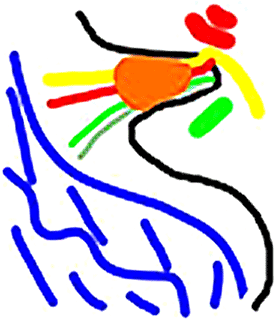Typing of acoustic neuromas
Wigand
WIGAND has defined a three-stage classification – see the schematic representations here:

Initial situation:
The tumour sits on the nerve in such a way that its weight prevents the blood supply required for proper nerve function (vascular compression).

Tumour size stage A:
The tumour is limited to the inner ear canal and its size (average diameter) is between 1 and 8 mm.

Tumour size stage B:
The tumour spreads into the cerebellopontine angle and has a size of between 9 and 25 mm.

Tumour size stage C:
The tumour has contact with the brain stem and is larger than 25 mm.
Samii
SAMII defines six tumour classes:
- T1: clear intrameatal tumour (in the bony ear canal)
- T2: intra and extrameatal tumour part (within and outside of the bony ear canal)
- T3a: Tumour fills the cerebellopontine cistern (between the cerebellum and brainstem)
- T3b: Tumour reaches the brainstem
- T4: Tumour compromises the brainstem
- T4b: Tumour compromises the brainstem and displaces the four ventricles (cerebral ventricle)
KOOS grading
Acoustic neuromas are often classified according to the Koos grading system.
| KOOS grade | Description | Tumor size |
|---|---|---|
| I | Small intracanalicular tumor that is located solely in the internal auditory canal (meatus acousticus internus). | < 10 mm |
| II | Mainly an intracanalicular tumor with protrusion (advancement) into the cerebellopontine angle, but without contact with the brain stem. | < 20 mm |
| III | A tumor located mainly in the cerebellopontine angle with contact with the brain stem, but without compression. | < 30 mm |
| IV | A large tumor with compression of the brain stem and the surrounding cranial nerves. | > 30 mm |
